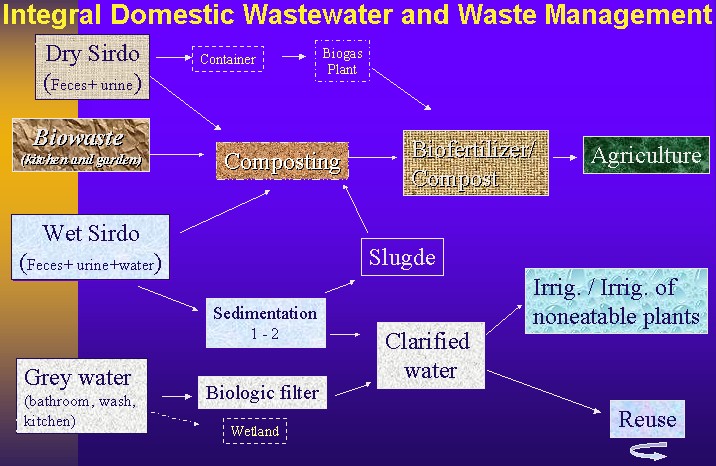| |
SIRDO (Integral system for recycling organic waste)
Final report
Lecturer: Josefina Mena Abraham, Arq.
Tutors:
- Ute Schneiderat
- Ana Isabel Zubiet
- Veronica Corella-Barud
Students:
- Verena Brand
- Yadira Cordero
- Stanislava Kocianova
- Catherine Wakesho
Objectives
- Install, demonstrate, monitor and analyze the compost and composting process in SIRDO from Suderburg.
- Analyze and compare samples between SIRDO and similar toilets visited during the excursions.
- Learn about the experience of GTA (Alternative Tecnology Group) from Mexico.
- Survey the social acceptability of composting toilets in Suderburg.
Abstract
- The lack of inadequate sanitation in the world which cause diseases and pollution, can be avoided with an
approach to the problem from the root level.
- New integrated sanitation and waste management systems will have to consider the different qualities of outputs
from human settlements: blackwater, biowaste, greywater and stormwater.
- Pollution prevention, sewage reduction and water conservation should be maximized.
Introduction
- The Paradoxes - Nearly half a billion people around the world face shortages of freshwater.
- In the year 2000 -1,615, 590 954 000 gallons of H2O will be flushed away daily in the U.S
[Porto & Steinfeld (1999)]
1000g feces flushed away leads to 50000g polluted water.
1000g feces decomposed gives 50 g humus to cure the mother earth.
Most of the domestic waste water generated is not treated - e.g. 56% of the developing
countries have no access to proper sanition [UNDP (2000)]
Health and sanitation
- An estimated 3 billion people lack a sanitary toilet.
(Hinrichsen, D., B. Robey, and U.D. Upadhyay.1998.
Solutions for a Water-Short World. Population Reports, Series M, No.14, Johns Hopkins University School of Public Health,
Population Information Program, Baltimore, Maryland)
Approximately 4 billion cases of diarrheal disease occur every year, causing 3-4 million deaths, mostly among children.
(See references cited in: Hinrichsen, D., B. Robey, and U.D. Upadhyay.1998. Solutions for a Water-Short World. Population
Reports, Series M, No.14, Johns Hopkins University School of Public Health, Population Information Program, Baltimore, Maryland)
Over 1.2 billion people are at risk because they lack access to clean water.
(See references cited in: Hinrichsen, D.,
B. Robey, and U.D. Upadhyay.1998. Solutions for a Water-Short World. Population Reports, Series M, No.14, Johns Hopkins
University School of Public Health, Population Information Program, Baltimore, Maryland)
Conventional Sanitary concepts to be considered.
I
Use of clean water (40%) to flush away toilet wastes
produces a break down by a process that utilises oxygen.
II
Mixing of industrial and domestic effluents.
III
Lost of nutrients which are contained in urine and feces.
INTRODUCTION 2
- To remedy these problems we need to
- conserve water
- separate constituents in waste waters
- recycle and reuse the water
- prevent pollution
- Dry and Wet SIRDO ( as examples) offer possibilities to attaining the mentioned goals
- So what does SIRDO offers?
|
|


